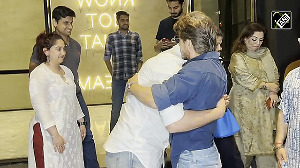In his weekly column of July 31, 2004, under the title "Tale of two companies", the editor of Business Standard, T N Ninan, has compared the performances of two leading companies, Hindustan Lever Ltd and ITC. The purpose of this article is to outline some lessons for corporate managers based on the performances of the two companies.
At the outset, I must declare my continued loyalty to HLL because I am a former chairman (19731980) of HLL and a former director (19791989) of its parent company, Unilever. However, I have tried to be as objective as possible in this analysis. No one in HLL has asked me to write this, nor has anyone provided any inputs.
The first lesson to be derived is that when a company has had a continuous record of growth in sales and profitability as HLL had for over 25 years, there is the danger of what may be termed as the "inertia of success".
The corporation tends to ignore the dangers of competition. That is what must have caused HLL's management to push up the margins on its products to a level that provided an umbrella for nimble competitors to eat into its dominant market share. It allowed Marico, Calvin Care, and P&G to gain a foothold in its space.
HLL is not the first company that has been affected by the inertia of success. IBM and General Motors, which were undisputed leaders in their respective fields, were beset with the same disease between 1972 and 1992. Their market shares were taken by Toyota and Apple.
Both IBM and General Motors had to take drastic steps to regain their dominant positions. The inertia of success is a disease that companies have to be vigilant about, especially when they have a decade or more of sustained high performance.
The second lesson is that the company's top management from the CEO downwards has to keep in touch with ground realities. Even with all the improvements in communication and reporting systems, there is no substitute for a first-hand gathering of information and impressions.
Slick presentations by intelligent and articulate managers in the head office are not a substitute for physical tours of the markets by the CEO.
In my experience, some of the wisest suggestions and observations about our operations and products have come from salesmen in the field when you spend time with them -- not in seminars held in five-star hotels but when touring in upcountry markets and sitting down with them at the end of the day to have a simple meal in a small town.
One is immersed in the realities of the market place -- what competition is doing, what the real consumer is feeling about our product, what the retailers and wholesalers are saying, what our own people really think. CEOs must tour, and do so without being insulated from realities by the pomp and splendour (garlands and tamashas) that tend to be laid on by overenthusiastic acolytes.
The third lesson for the Indian subsidiary of a multinational is that when necessary its CEO should have the courage of conviction to stand up to pressures from the head office of the MNC. In the case of HLL, one wonders whether pressure from Unilever and its chairman had persuaded HLL's top management in the late 1990s to focus too much on margins without realising the vulnerability of market shares.
To withstand such pressures and assert the local view based on ground realities is one of the key functions of the CEO. Even if it were to involve some temporary discord with London, HLL's chairman has to do it because he is accountable also to the large body of Indian shareholders.
Based on my experience at the headquarters of a multinational, no sensible CEO of a multinational company will try to second guess or overrule the judgement of a local CEO with a successful track record if that judgement is well founded and put across clearly and consistently.
The fourth lesson is that to sustain growth in size and profitability, a company has to innovate and change. One of the consequences of the "inertia of success" is that this process of innovation tends to slow down.
Relaunching old products with new packaging or perfumes and new advertising campaigns does not constitute the kind of innovation that can ensure sustainable growth. HLL has a strong R&D base, which is manned by highly qualified and competent Indian scientists and engineers.
The company has a creditable record of innovations, e.g. the detergent bar (Rin) and the skin-lightening cream (Fair & Lovely), both produced by Indian R&D managers in the 1970s. Both these products revolutionised the market for their respective product segments and have continued to be great successes despite imitative competition.
After a gap of over 25 years, HLL is now test marketing another potentially revolutionising product for domestic water purification. In today's fast-changing world, 25 years is too long a gap to bring out the next innovative product.
The speed and success of innovation depend on the strength and vitality of the link between R&D and the top management, including CEO. If that link is vibrant, it should not take 25 years for the next revolutionary product.
The lesson to be drawn is that the CEO and top management have to maintain the vitality of the link between R&D and the business. It does not require a scientist or a technologist as CEO to make the link effective.
What it needs is the willingness to devote time, to bring commonsense assessments of the R&D effort, and to provide stimulation and motivation to the R&D team so that they become part of the business.
The fifth lesson is that each company has its own history and culture (or DNA, as Mr Ninan put it), which each generation of management can draw upon. HLL is a company that survived the near fatal onslaught of price controls and FERA in the 1970s and competition from Nirma in the 1980s. It did so through innovative responses.
The DNA does not change with time. What it requires is perhaps a shaking out of the inertia of success. Recent setbacks in performance and the widespread adverse comments have hopefully provided enough stimulus for HLL's management to overcome it. Its DNA is still intact and will see it through.
The DNA of ITC, by comparison, is that of a company that is in the "sin" business, as Mr Ninan put it. And that DNA cannot be changed. Despite an opportunistic diversification into hotels and FMCG, tobacco remains its core business, which sustains it.
One of the basic tenets of corporate governance is duty to consumers. How can one reconcile that with the product range that by all available evidence can cause cancer through its use?
Perhaps, ITC may have to be born again without its tobacco business to redeem its DNA.





 © 2025
© 2025